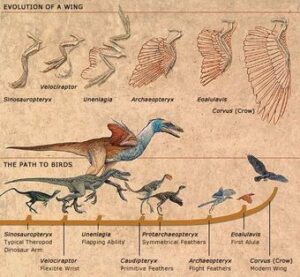Back to: ZOOLOGY 300 Level
Welcome To Class!
Hello my amazing friend! It’s always great to have you here. Today, we’re going to take a little journey into the past — waaay back to the time of dinosaurs — to learn how the birds we see flying around today, from the chickens in your compound to the eagles in Jos, came to be. Get ready, because the story of avian evolution is truly one of nature’s greatest transformations!
Archaeopteryx And Avian Evolution
Who or What Is Archaeopteryx?
Archaeopteryx (say it like: ark-ee-OP-ter-iks) is considered one of the earliest known birds. It lived about 150 million years ago during the Jurassic period, when dinosaurs ruled the Earth.

It’s special because it had features of both dinosaurs and birds. Imagine seeing a chicken with teeth and claws on its wings — that’s the kind of creature Archaeopteryx was! It had feathers like a bird but also a long bony tail, teeth, and clawed fingers like a reptile. It was like the “missing link” between reptiles (specifically theropod dinosaurs) and modern birds.
Fossils of Archaeopteryx were first discovered in Germany in the 19th century, and scientists immediately noticed that this creature was a bridge between two worlds — the reptilian and the avian.
What Makes Archaeopteryx Important in Avian Evolution?
Archaeopteryx gives us physical proof that birds evolved from dinosaurs — particularly from small, meat-eating ones called theropods (think of Velociraptor). It’s like how looking at your grandfather’s old photos shows the family resemblance — the connection is clear!
Its feathers were important not just for flight, but possibly also for insulation (keeping warm) or even display. The structure of its wings and feathers tells us that it could probably glide or flap weakly — maybe not like a hawk, but definitely more than just falling with style.
This animal helps scientists understand how flight might have started — first as a way to escape predators, then later as a way to hunt or move efficiently.
How Did Modern Birds Evolve from Dinosaurs?
After Archaeopteryx, other bird-like dinosaurs began to show more advanced features: lighter skeletons, better feathers, and more efficient lungs. Over millions of years, these changes gave rise to the birds we know today.

Modern birds no longer have teeth or long tails. Their bones are hollow to reduce weight. They have powerful flight muscles and beaks suited for different diets — from the grain-picking chickens in Abeokuta to the fish-hunting kingfishers in Niger Delta.
This slow but steady change from ground-running reptiles to sky-surfing birds is a beautiful example of evolution through natural selection.
Summary
- Archaeopteryx was an ancient creature with both bird and reptile features.
- It proves that birds evolved from dinosaurs, especially small theropods.
- Over time, birds developed flight adaptations like feathers, hollow bones, and beaks, replacing teeth and tails.
Evaluation
- What makes Archaeopteryx an important fossil in the study of bird evolution?
- List three features of Archaeopteryx that show its link to both birds and reptiles.
- How do modern birds differ from their dinosaur ancestors?
- Why are feathers considered important in avian evolution?
You’ve done so well today, and I’m proud of you! Just like birds evolved and took to the skies, your knowledge is taking flight every time you show up to learn. Keep soaring, and remember — Afrilearn is always here, supporting your journey to greatness. See you in the next lesson, champ!
